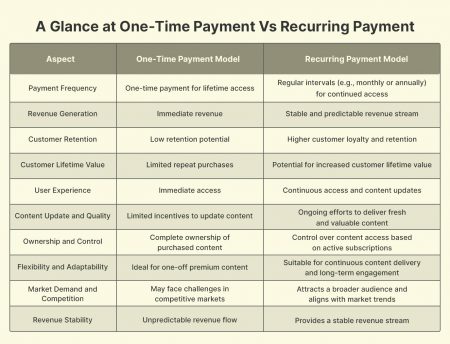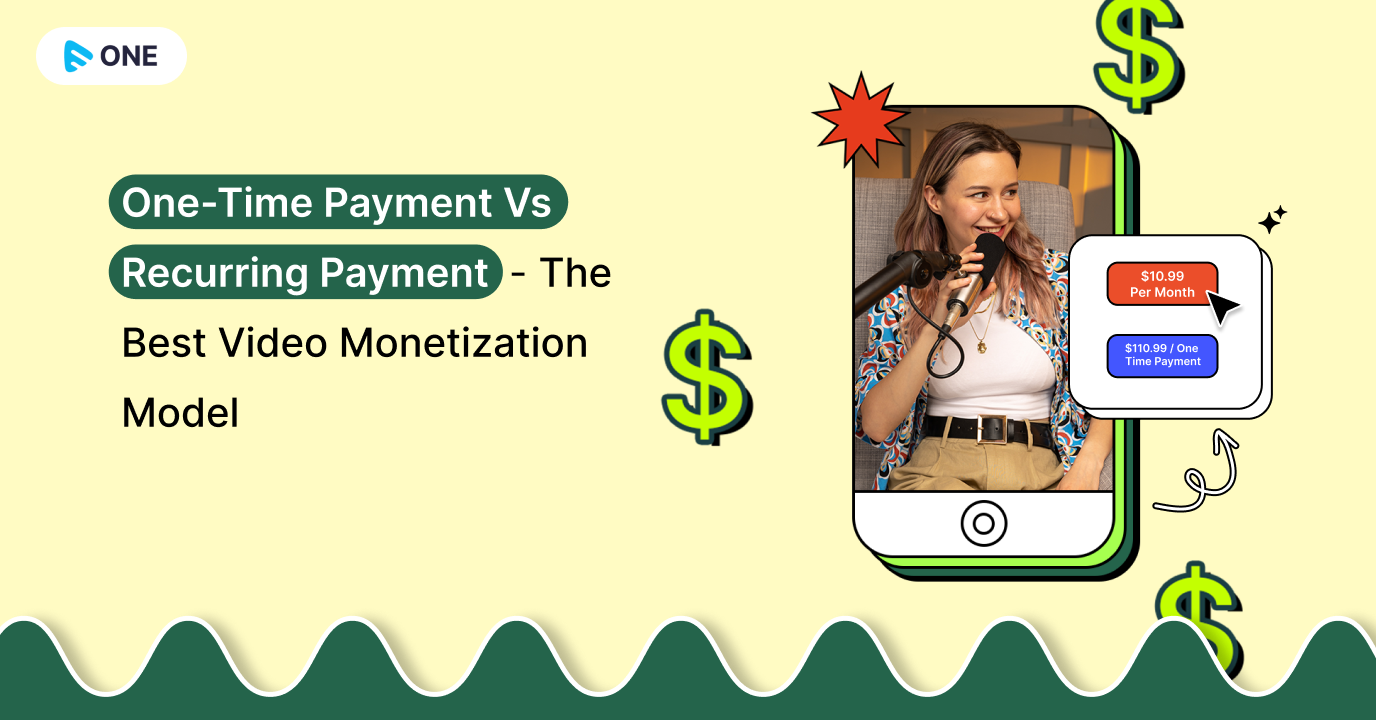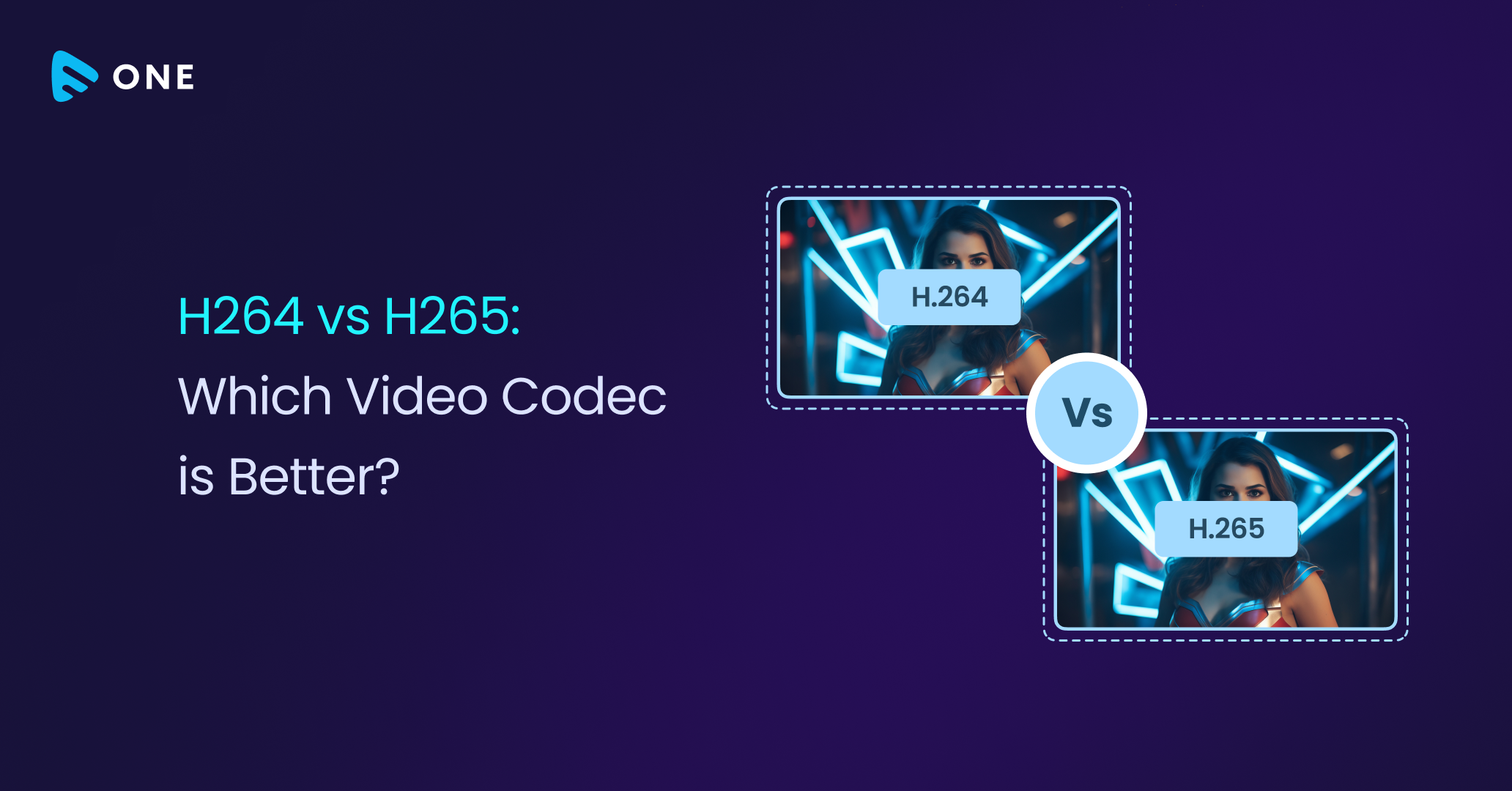Are you confused between choosing one-time payment vs recurring payment for your streaming business?
Yet to decide which one is better in the long run in terms of business revenue?
Well, it’s not only you!In the fiercely competitive market of streaming businesses, the choice between one-time payment vs recurring payment has become a pivotal determinant of success and streaming businesses are striving to opt the best for themselves.
As the popularity of online streaming continues to soar, millions and billions of users worldwide are embracing these platforms for their entertainment needs. And in order to unleash this growth scope, it’s crucial to choose the right monetization model for your business.
Each model comes with its own set of advantages and drawbacks, catering to diverse consumer preferences and business objectives. This makes it even more difficult to make a choice. And so, to ease your task, in this blog, we explore the significance of selecting the right payment model – a decision that directly influences customer engagement and revenue generation.
So, one-time payment vs recurring payment – which one is better for your streaming business? Let’s find out!
What Is One-Time Payment?
One-time payment refers to a single, upfront transaction made by a user to access content or services provided by a streaming business. In this payment model, customers pay a fixed fee to enjoy a particular piece of content, typically without any recurring charges.
One-time payments are commonly associated with the pay-per-view approach, where users purchase individual movies, shows, or other digital content on a per-item basis.
Numerous streaming businesses have adopted the one-time payment model to cater to specific audiences or offer premium content options. For instance, video-on-demand platforms like Amazon Prime Video and Google Play Movies allow users to rent or purchase individual movies for one-time viewing.
Similarly, music streaming services like iTunes and Bandcamp offer songs and albums for direct purchase without requiring users to subscribe to a monthly plan.
What Is Recurring Payment?
Recurring payment, also known as a subscription model, is a monetization model where customers are charged at regular intervals, typically monthly or annually, to access content or services provided by a streaming business.
In this model, users sign up for a subscription plan, granting them ongoing access to a wide range of content as long as they maintain their subscription status.
A lot of streaming businesses have opted for the recurring payment model, as it provides a steady and predictable revenue stream. Popular examples of streaming platforms using this approach include Netflix, Hulu, and Spotify.
One-Time Payment Vs Recurring Payment in Video Monetization: A Comparative Guide
One-time payment vs recurring payment – choosing the right payment model can significantly impact the success of a streaming business. And here’s a side-by-side comparison to help you choose the best option.
1. Initial Cost Analysis
The one-time payment model entails customers making a single transaction to gain lifetime access to the video content. From an initial cost perspective, the one-time payment model appears advantageous due to the immediate revenue it generates.
Streaming businesses receive upfront payments for each purchase, allowing them to recuperate the production and marketing expenses associated with the content quickly. This immediate revenue can be beneficial for smaller businesses or individual streaming businesses with limited financial resources.
However, the initial cost analysis for the one-time payment model must also consider the potential limitations in revenue generation. Since users pay only once for access, there is limited potential for continuous revenue from the same customers. This may necessitate continuous efforts to attract new customers to sustain revenue growth.
Moreover, in the one-time payment model, streaming businesses may need to invest more in marketing and customer acquisition to reach a broader audience. This could entail higher advertising costs, promotional campaigns, and other marketing activities to encourage individuals to make the one-time purchase. Consequently, the initial cost analysis for the one-time payment model must account for these marketing expenses as well.
In contrast, the recurring payment model involves charging users at regular intervals (e.g., monthly or annually) for continued access to the video content. The initial cost analysis for the recurring payment model may show lower upfront revenue compared to the one-time payment model, as customers pay smaller amounts regularly instead of a lump sum.
However, the recurring payment model offers unique advantages that can contribute to a more stable and sustainable revenue stream.
One of the key benefits of the recurring payment model is its potential for predictable revenue. streaming businesses can forecast revenue with greater accuracy since they have a consistent stream of payments from active subscribers.
This revenue stability allows businesses to plan their financial resources more effectively and allocate budgets for content creation, platform enhancement, and marketing campaigns.
The initial cost analysis for the recurring payment model should also consider the potential administrative overhead involved in managing recurring billing. Businesses may need to invest in payment processing systems, customer support infrastructure, and subscription management tools.
While these initial costs might be higher, they can be offset by the stable revenue stream and increased customer retention over time.
2. Revenue Potential
The one-time payment model presents a revenue potential that is directly tied to the number of individual content purchases. For streaming platforms that have a vast library of content, this model can be advantageous, as it encourages users to explore a diverse range of videos.
However, the challenge lies in driving repeat purchases and maintaining user engagement, especially for platforms with limited content offerings. To maximize revenue potential, businesses employing the one-time payment model need to focus on continuously refreshing their content library and offering exclusive or time-limited content to entice users to make more purchases.
The recurring payment model, on the other hand, offers the potential for long-term, sustainable revenue growth. As subscribers pay regular fees, streaming businesses can accurately forecast their income and allocate resources more effectively for content creation and platform improvements.
Moreover, the subscription model fosters customer loyalty, as subscribers are incentivized to make the most of their ongoing investment by regularly engaging with the platform’s content.
For businesses that can consistently provide high-quality and engaging content, the recurring payment model offers substantial revenue potential and opportunities for scalability.
3. Flexibility and Adaptability
A one-time payment model, as the name suggests, allows users to make a single transaction to gain access to the video content permanently. It offers a straightforward approach and appeals to users who prefer a one-and-done commitment.
From a business perspective, this model can be an excellent choice for one-off or premium content, such as workshops, masterclasses, or exclusive documentaries.
One of the key benefits of the one-time payment model is its simplicity, which makes it easy for both streaming businesses and users to understand. They can price their content appropriately, and users can enjoy lifetime access without worrying about recurring fees.
This can be particularly attractive to individuals who prefer to have complete ownership of the content they purchase.
However, the one-time payment model might not be ideal for all types of video content. For businesses aiming to build a steady stream of revenue, this model may limit their earning potential.
Additionally, as user preferences shift towards subscription-based services, the one-time payment model might face challenges in gaining popularity.
The recurring payment model has gained immense popularity in recent years due to its potential for generating consistent revenue streams and fostering long-term customer relationships.
For streaming businesses, the recurring payment model provides a stable income flow, enabling them to invest in ongoing content production and improvements. Moreover, subscriptions foster a sense of loyalty among users who become more invested in the platform and its content as they continue to pay for it.
4. User Experience
The user experience in the one-time payment model is relatively straightforward. Once the payment is made, users typically gain instant access to the video content, eliminating any waiting periods or recurring authorization requirements. This simplicity can be attractive to users who appreciate a seamless and immediate transaction process.
Furthermore, the absence of recurring billing in the one-time payment model means users won’t face any unexpected charges or subscription renewals. For those who prefer to make a single payment and be done with it, this model offers peace of mind and a sense of control over their expenses.
However, the user experience in the one-time payment model may not suit those who consume video content regularly or desire continuous access to fresh content. Additionally, if a user loses access to the content due to unforeseen circumstances or accidental deletions, they may have to make another payment to regain access, which could lead to dissatisfaction.
On the other hand, the user experience in the recurring payment model revolves around the convenience of continuous access and frequent updates. Subscribers can access the entire library of video content as long as their subscription is active.
This model fosters a sense of community and engagement among subscribers, as they are part of an ongoing relationship with the streaming business or platform.
Moreover, the recurring payment model often provides personalized recommendations and tailored content based on user preferences and viewing history, enhancing the overall user experience. As users get accustomed to regular updates, they are more likely to return frequently, creating a habit of using the platform.
However, the recurring payment model might face challenges in terms of user retention. If the content fails to meet expectations or if competitors offer better alternatives, subscribers may choose to cancel their subscriptions, leading to a loss of revenue for the streaming business.

5. Scalability and Growth
When it comes to scalability and growth, the one-time payment model in video monetization may face some challenges. While it offers simplicity and immediate revenue generation for streaming businesses, its scalability potential is limited.
Since users only make a single payment to access the content permanently, there is no ongoing revenue stream from the same customers. This can hinder the ability to invest in content improvements, platform enhancements, and marketing efforts necessary for sustained growth.
For instance, if a streaming platform launches a new video course with a one-time payment option, they may experience a surge in revenue initially as users purchase the content. However, once most of the target audience has acquired the course, the revenue generation may stagnate unless new content offerings are constantly introduced to attract new customers.
Moreover, the one-time payment model might not incentivize streaming businesses to continuously engage with their audience or invest in long-term growth strategies. Without recurring revenue, businesses might lack the resources to expand their offerings, improve the platform’s user experience, or implement marketing campaigns to reach a broader audience.
The recurring payment model, on the other hand, offers significant scalability and growth opportunities for video monetization. With a subscription model, streaming businesses can establish a steady stream of revenue that grows over time as they attract and retain subscribers.
The potential for recurring billing allows businesses to allocate resources for consistent content production, platform enhancement, and marketing efforts, driving continuous growth.
As the subscriber base increases, the revenue scales accordingly, providing businesses with a stable foundation to invest in the expansion of their content library and deliver higher value to their audience.
The subscription model fosters a long-term relationship with customers, leading to better customer retention and increased customer lifetime value. Additionally, the subscription model opens up opportunities for streaming businesses to explore innovative ways of engaging their audience.
They can experiment with different content formats, such as live streaming, exclusive events, and interactive sessions, thereby enhancing the overall user experience and further driving growth.
6. Long-term Sustainability
While the one-time payment model may provide immediate revenue, its long-term sustainability can be a concern. Since users gain lifetime access to the content, there is little incentive for them to make additional purchases on the platform unless new content is continually introduced.
As a result, streaming businesses relying solely on one-time payments may find it challenging to sustain revenue growth in the long run.
Furthermore, the lack of recurring billing in the one-time payment model means that streaming businesses need to continually attract new customers to maintain revenue levels. This can be resource-intensive, especially in competitive markets where customer acquisition costs are high.
In terms of content sustainability, the one-time payment model might not encourage businesses to update or refresh their existing content frequently. Once the content is created and sold, there may be little motivation to invest in updates or improvements, leading to a stagnant content library over time.
On the contrary, the recurring payment model offers greater long-term sustainability for video monetization. With a subscription model, streaming businesses can build a loyal and engaged customer base, leading to a consistent revenue stream that can endure for an extended period.
The recurring billing aspect ensures that revenue keeps flowing in as long as subscribers remain active, which allows streaming businesses to plan and invest in long-term strategies. This financial stability fosters a conducive environment for content improvement, platform development, and expansion of services, all of which contribute to the sustainability and growth of the video monetization business.
Moreover, the subscription model’s emphasis on customer retention encourages businesses to consistently deliver valuable and engaging content. As subscribers receive ongoing updates and fresh content, they are more likely to remain loyal to the platform, enhancing long-term sustainability.
7. Control and Ownership
The one-time payment model in video monetization offers streaming businesses a high level of control and ownership over their content. With this model, businesses have the autonomy to set the price for their videos and determine how they want to distribute their content. They can choose whether to host the videos on their own website or through third-party platforms.
Streaming businesses who opt for a one-time payment model can also decide on any additional terms and conditions for content usage, copyright, and distribution. This level of control allows businesses to protect their intellectual property and ensure that their content is used in accordance with their preferences.
Moreover, with the one-time payment model, streaming businesses don’t have to share a percentage of their earnings with a platform or pay transaction fees for each sale. This means they can retain a higher percentage of the revenue generated, making it an attractive option for those who value ownership and independence.
However, with control comes responsibility. Streaming businesses using the one-time payment model need to handle customer support and payment processing themselves, which can be time-consuming and require additional resources.
In the recurring payment model, streaming businesses still retain a degree of control and ownership over their content, but it may be somewhat limited compared to the one-time payment model. With the subscription model, businesses can decide on the content offerings available to subscribers and the pricing structure for different subscription tiers.
Streaming businesses can also implement content restrictions and user permissions based on subscription levels, providing them with some control over content access. For example, they may offer exclusive content to higher-tier subscribers, enticing users to opt for more expensive subscriptions.
However, since the content is provided on a subscription basis, subscribers gain access to the content only as long as their subscription is active. This means that streaming businesses must continuously engage subscribers with fresh and valuable content to ensure retention.
The control over the duration of access lies in the hands of the subscribers, which is a trade-off for the recurring revenue stream.
8. Market Demand and Competition
The market demand for one-time payment video content varies depending on the type of content and target audience. Certain niche markets may prefer the one-time payment model for specific premium content offerings. For instance, individuals seeking to purchase a tutorial or a specialized course may prefer to make a one-time payment to gain lifetime access to the content.
In some cases, customers may prioritize ownership and avoid subscription commitments, making the one-time payment model an appealing option. However, as the market trends shift towards subscription-based services, the demand for one-time payment video content may face challenges in the face of fierce competition.
Competition in the one-time payment model arises from other streaming businesses offering similar video content with different pricing or additional perks. streaming businesses must ensure that their offerings stand out in terms of quality, uniqueness, and value to attract customers in a competitive market.
The recurring payment model has witnessed significant growth due to the increasing market demand for subscription-based services across various industries, including video content. Subscribers are attracted to the convenience, affordability, and continuous access that subscriptions offer, making it an appealing choice for both consumers and streaming businesses.
The market demand for subscriptions is further driven by the rise of streaming platforms and the prevalence of online video content consumption. The popularity of subscription-based video streaming services, such as Netflix and Disney+, has set a consumer expectation for accessible, on-demand content with a recurring payment model.
With the rise in demand, competition in the subscription-based video monetization space has intensified. streaming businesses must carefully analyze their target audience, content offerings, and pricing strategies to effectively compete in this market.
Offering unique content, personalized recommendations, and flexible subscription options can help businesses stand out and attract a loyal subscriber base.
A Glance at One-Time Payment Vs Recurring Payment

One-Time Payment Vs Recurring Payment: Which One To Choose for Your Streaming Business?
Both the one-time payment and recurring payment models have their strengths and weaknesses. While the one-time payment model offers immediate revenue and simplicity, it may struggle to sustain long-term growth and customer retention.
On the other hand, the recurring payment model provides predictable revenue and fosters customer loyalty, but it requires consistent efforts to retain subscribers and manage recurring billing.
For a well-rounded streaming business, it is recommended to consider offering both payment models. Certain premium content or one-off events can be priced as one-time purchases, attracting customers who prefer immediate access and ownership.
Meanwhile, a subscription-based model can be implemented to cater to a broader audience, providing a stable revenue stream and long-term customer relationships.
Muvi One empowers you to launch your own branded OTT platform effortlessly where you can seamlessly implement both one-time payment and recurring payment (subscription) models, unlocking diverse monetization opportunities for your streaming business. It offers a complete no-coding solution to launch your OTT platform and set up your monetization model.
Also, it offers a range of competitive features like –
Take a 14-day free trial today to know more (no credit card needed).

FAQs
- What is the difference between one-time and recurring payments?
The difference between one-time and recurring payments lies in the payment frequency. One-time payments allow users to make a single transaction for lifetime access, while recurring payments charge users at regular intervals for continued access to content or services.
- What are the advantages of using a subscription-based business model?
Subscription-based business models offer stable and predictable revenue streams, foster customer loyalty, and encourage ongoing customer engagement. Subscribers pay at regular intervals, ensuring a continuous relationship between the business and its customers.
- How do one-time payments affect revenue generation?
One-time payments can provide immediate revenue but may limit long-term revenue potential. Since customers pay only once, businesses must continually attract new customers to sustain revenue growth.
- What payment options are available for recurring billing?
Recurring billing options include credit/debit cards, digital wallets, and online payment platforms. Businesses can offer various payment methods to accommodate customer preferences and enhance the user experience.


















Add your comment